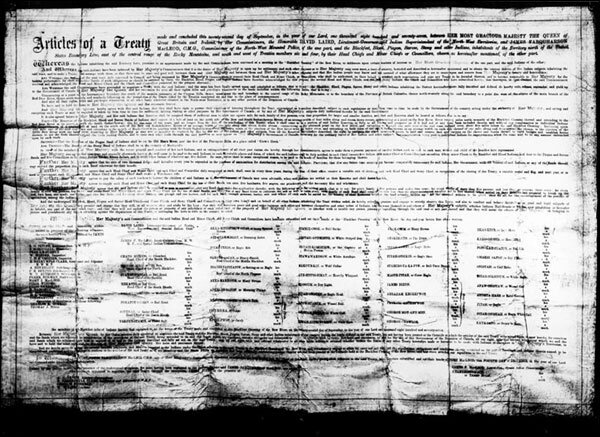First Nations People and the Signing of the Treaties
One of the few images of the signing of Treaty #7. Crowfoot is speaking.
Treaty #7.
In 1870, Canada finalized the purchase of Rupert's Land and the North-West Territories from the Hudson's Bay Company. As part of the transfer, the government was to take care of the Indigenous people within this area. South of the border, Indigenous people were placed on reservations after much bloodshed. The Canadian government took a different approach.
While the North-West Mounted Police force was sent west to stop the whisky trade, it had another equally important role: to pave the way for settlement. Many of the Indigenous leaders were grateful for the eradication of the whisky trade - they had seen their own people fight and kill each other over the evil brew, and trade away everything they owned until they were destitute. Their people had already been ravaged by smallpox and other epidemics. The buffalo were disappearing. The leaders knew that life was going to change, and drastically.
The NWMP had helped the Indigenous people. They treated them fairly and won their respect. The Indigenous people listened to their counsel, and when the government was ready to make treaties in the west, many Indigenous people were ready to sign.
The Indigenous people were well aware that they could not do much to stop settlement from happening. They could however, make the best deal possible for their people.
The government entered into treaty negotiations first with those tribes who seemed the most likely to accept their offer. Treaties included identifying reserves for the tribes who signed, hunting and fishing rights, annual cash payments to every member, a lump-sum signing payment and medals, flags and chiefs' uniforms. The Indigenous people demanded schools on the reserves, farming implements, seed, farm animals and agricultural instruction, and the prohibition of liquor in their communities. Some, like the Cree, were able to negotiate medicine when needed, and food in years of famine.
Some Indigenous people refused to sign treaties at first. While there were still buffalo to hunt they could see no advantage to settling on reserves. When the buffalo disappeared, the people starved, and the government would not issue any food to Indigenous people who had not signed a treaty. Finally even hold-outs like Big Bear had to sign the treaty or see their people die.
The three treaties signed in the west during the early days the NWMP were Treaty 6, Treaty 7 and Treaty 8. Each treaty settled with a different group of Indigenous people in different parts of the west.
To find out more about the the communities who signed these three treaties, use these links:


